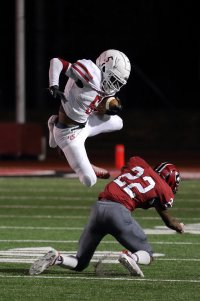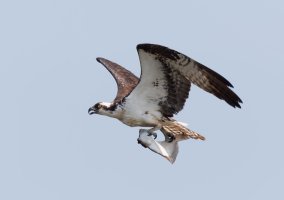I had 7D and 7D Mk11. I agree that noise was an issue, particularly with the original 7D, in fact I was very reluctant to shoot at higher than ISO800 with either camera. The 7DMkii had good AF in bright light, but had major problems hunting with low contrast subjects in poor light, and it was pretty hopeless at tracking subjects as they moved towards the camera in SERVO mode. When I referred to it being a pro-level camera, I should really have made it clearer that I was referring to build quality, rather than image quality or AF performance.
I found the AI SERVO performance tracking athletes moving directly towards the camera to be excellent with the 7D Mark II.

This is an 1877x2816 vertical crop of a 5472x3648 horizontal shot. EOS 7D Mark II + EF 70-200mm f/2.8 L IS II, ISO 3200, f/2.8, 1/800 at 200mm. I've got a six or seven frame burst of this attempted tackle and leap and all of them are as well focused as this one, which was the frame with the peak action. That's not atypical at all for the 7D Mark II. Once you learn how to harness the capabilities of the AF system and customize it to your preferences, it's very reliable and consistent.
The 7D was so bad doing the same thing I had started using my 5D Mark III as my "long body (w/ 70-200mm f/2.8 lens)" for night/gym sports under the lights and using my 5D Mark II with entry level AF for my "wide body (w/ 17-40/4, 24-70/2.8, or 24-105/4)". I did continue to use the 7D with daylight illuminated field sports where the higher pixel density of the 7D vs. the 5D Mark III still allowed more cropping.
My experience with the 7D had led me to the decision to never buy another APS-C body. Then I read
Bryan Carnathan's review that showed how well the flicker reduction feature worked and then read what Roger Cicala said about the 7D Mark II's improved AF performance in the opening paragraph of his
blog entry about a 7D Mark II teardown. In June of 2015, looking ahead to football/marching band season beginning in August, I decided to give the 7D Mark II a shot. The decision was made easier by the price having dropped to $1,499 USD during the June promotional rebates. I'm glad I did.
Flicker reduction alone was revolutionary for my major use cases. I lost more shots that would have otherwise been "keepers" (peak action that was in focus) to light flicker issues than to AF issues with all of the cameras I used that did not have it. Frames with one side bright and "blue" and the other side dim and "brown" were a pain when they could even be dealt with at all in post. Every. Single. Frame. had to be custom white-balanced in post, and many still looked too bad to be usable. Flicker reduction not only normalizes the color to near uniformity from shot to shot, allowing batch processing of almost all of the images from a shoot under the same lights, but since it releases the shutter at the peak of the light cycle, it also allows faster Tv or lower ISO for the same shooting environment by as much as 1/2 to 2/3 of a stop in the facilities where I regularly shot.
At the time the 7D Mark II was introduced in late 2014 the only other body to offer flicker reduction was the 1D X, which was out of my realistic price range. The 5D Mark IV, introduced in 2016, was the first 5-series to include it.


